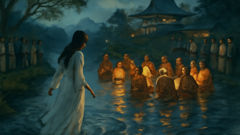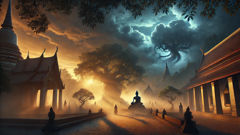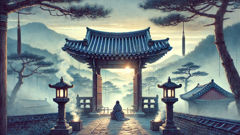Introduction
The river remembered before the town did. It kept the names of fishermen and the trajectories of leaves; it stored the slow, patient motions of things that lived longer than the walls of houses and the span of human memory. Here, in the low-lying marshes and willow-line banks of Jiangnan, the White Snake first uncoiled her long attention. She had been a being of long cold years—an intelligence folded into the glint of moonlit scales, a creature that learned from seasons rather than sermons. Curiosity arrived like a warm current: a drift of questions about feet, about laughter, about hands that could hold another's. She watched market days, borrowed the cadence of speech from tea-sellers, rehearsed gentleness from old women who mended silks by the water. The more she watched, the more she felt an ache that was not hunger but an anterior kind of wanting. To be human was a rumor she tasted; to love and be loved, a rumor she inhaled with each ripple. This is not the tidy pilgrimage told on festival stages where names separate neatly into hero and villain. It is a deeper mapping that traces how a spirit learns to walk among humans and how those same humans—some tender, some cruel, some rigid in law—learn to name the strange affection that binds them. Across temples and teahouses, under candled altars and in the hush of midnight pavilions, the White Snake's transformation becomes a study of translation: from scale to skin, from hunger to longing, from silence to the lyrics of ordinary life. It is here you find Xu Xian, with practical hands and an honest, small-hearted kindness; Fahai, with robes like a horizon of iron laws; villagers carrying thunderous superstitions folded beneath umbrellas; and the river, forever bearing witness to how love erodes rock and shifts silt, how it rearranges what was thought permanent. The tale that follows walks the margins between wonder and prescription—between what a community decides must be condemned and what a private heart insists upon keeping. It asks not only whether a spirit can become a human, but whether a human can contain a spirit's breadth without breaking. It asks what stories we inherit when we worship, when we judge, and when we forgive.
Origins, Shapes, and the Strange Grammar of Yearning
The earliest imaginations of the White Snake are often told in shorthand: a being of serpentine origin who learns to love a man named Xu Xian, is opposed by a monk called Fahai, and suffers the consequences. Those are the bones. The deeper cuts reveal the muscle and marrow: why a spirit would long for a life framed by fragile, mortal flesh; what it means for a community to name transgression when transgression also looks a lot like fidelity; and how transformation acts as a grammar of desire in a world where boundaries are porous.

In older, less neat versions of the legend—told in lantern light to children who were not yet afraid of monsters—the White Snake is not simply a temptress nor purely an allegory of sin. She is an awareness that grew inside an animal. She learns by imitation, yes, but also through the slow accretion of attention. A dragonfly's flight taught her timing; a fisherman's song taught her cadence; an aging woman's tremor taught her compassion for joints that no longer obey. When she becomes Bai Suzhen, she does not steal humanity; she earns it in small, unglamorous transactions: in buying rice from a stall and failing to calculate change at first; in learning the ache of labor after carrying sacks; in the humiliation of being refused entry to a household because her shoes are unfamiliar.
There is a deliberate cruelty in some tellings, as if the universe itself were testing whether a spirit's claim to love can ever be legitimate. But consider the economy of empathy Bai Suzhen accumulates. She practices speech until the rhythm of vowels feels like the tide. She learns to bear grief and to hold a new life steady against sudden storms of fortune. When she steps across thresholds in embroidered robes, she is not merely wearing new cloth—she is trying on histories and obligations. This is important because love, in these deeper cuts of the tale, is not an instantaneous inhalation. It is an apprenticeship. The White Snake learns the domestic crafts of patience and repair. She learns to keep track of debts and birthdays; she learns that trust is not a single heroic act but thousands of small and unremarkable gestures.
Xu Xian, by contrast, offers the ordinary virtues that the spirit has observed from a distance: steadiness, an easier laugh, the reflex toward unassuming goodness. He is not the great warrior or the philosopher who can parse the cosmic meaning of spirits. He is a pharmacist and a man who folds his life with clean motions. He tends his shop with reverence for remedies both botanical and human, and it is in that modest intimacy—preparing medicines, listening to customers' confidences, tending to the frail—that Bai Suzhen discovers what it means to be needed without spectacle. Their courtship is less the swooping romance of later stagecraft than a mutual apprenticeship. She offers the patient devotion of an entity that has watched seasons; he offers the ordinary trust that has fed many small hopes. Their union becomes, in its own terms, an experiment about whether different temporalities—one slow and accumulative, one bounded by an ephemeral human life—can actually cohabit.
This leads to the knot of conflict that gives the tale its moral friction: the community and its laws. Monks like Fahai appear in multiple versions as enforcers of a cosmic order. In some variations, Fahai is drawn less by doctrinal righteousness and more by a personal code of separation—an insistence that the world of men be clear of spirits that unsettle social rhythms. His opposition often reads as the voice of institutional authority: a guardian of boundaries whose duty is to maintain the predictable taxonomy of beings. Yet when we cut deeper, Fahai is not simply a cardboard villain; he often carries a credible fear. To a monk who has watched spirits seduce and destroy, the possibility of transcendence through transgression feels like a contagion. Where Bai Suzhen sees possibility, Fahai sees the collapse of the delicate social agreements that allow villages to persevere across famines, floods, and political turbulence.
What the deeper tellings complicate is the idea that law and love are oppositional abstractions. Instead, they reveal a dialogic tension. Law emerges from cumulative stories that have helped communities survive; love interferes with those narratives in unpredictable ways. Bai Suzhen's presence forces the village to confront the limitations of its categories—what to do when tenderness springs from an unexpected source, or when an act of compassion looks like a refusal to obey a taboos' logic. The drama is not merely theological; it is domestic and communal: neighbors whispering, friends recalculating alliances, a temple ledger thickening with offerings and curses.
There are moments in these layered retellings when the supernatural is almost incidental. The White Snake's white robes, the glint of scales when she moves too quickly, the salt of tears on her cheeks—these details are shorthand for a larger interrogation about belonging. What does it cost a community to exclude someone who loves well? And what does it cost an individual to hide the full measure of themselves to gain acceptance? Bai Suzhen chooses exposure. She opens herself to being seen, vulnerable to the very human repercussion of gossip, betrayal, and fear. That choice reframes the narrative: she is not only pursuing romance but also testing a social hypothesis—that the moral muscle of a village can expand enough to contain difference. Often, when stories are told by candlelight, an older listener will add a low caveat: such tests do not always succeed. Sometimes the river takes back what was borrowed, and sometimes the dead keep their old shapes. But the telling itself keeps alive a different measure: a measure of compassion that refuses tidy partitioning between the living and the otherwise.
Flood and Judgment: Jinshan, Fahai, and the Weight of Memory
No retelling of the White Snake reaches its emotional pinnacle without the legend of Jinshan Temple and the flood, a sequence that crystallizes the conflict between private devotion and public duty. In the more schematic narrations, the flood is a spectacle: a monk's exorcism, a woman unmasked, a husband betrayed. In the deeper cuts, we find a slow-motion catastrophe where water and law intersect; where a landscape shaped by seasonal inundation becomes the stage for ethical and infrastructural anxieties.

Jinshan Temple perches like a stern punctuation on the river's lip. It has existed for generations as a place where the community makes sense of catastrophe: offering prayers for harvest, burning incense for ancestors, and occasionally, adjudicating whether a misfortune is natural or caused by an unquiet spirit. Temples collect narratives through ritual, transforming ephemeral tragedies into storied lessons. When Bai Suzhen and Xu Xian's love begins to tug at the social seams, Jinshan becomes the place where fear translates into action.
The flood legend is not an accident of drama but a culturally precise image. Jiangnan, the region where the story is often situated, has historically been shaped by water management—the raising of dikes, the negotiation of river channels, the collective labor of a populace that knows water can be generous and annihilative in equal measure. In this context, concern about spirits is also a codified anxiety about ecological unpredictability. To accuse a spirit of causing flood is, in older epistemologies, to make sense of risk: to provide a scapegoat narrative that makes communal action possible. Evictions of spirits, then, function like attempts to divert a river's course. Fahai's exorcism is as much about reasserting human control over a landscape as it is about enforcing metaphysical purity.
Those historical considerations don't justify cruelty, but they do give the characters' choices moral gravity. Fahai believes his actions preserve communal life. He fears that to allow spirits free reign is to invite arbitrary calamity. When he confronts Bai Suzhen at Jinshan, he interprets her love as destabilizing: a seduction not only of a man but of a social order. His remedy is theater and force—ritual words, sacramental implements, the raising of a barrier between humanity and the otherwise. He calls upon Buddhist injunctions and the authority of the temple to legitimize his judgment.
Bai Suzhen's response is not merely personal defense but a demonstration of the costs of exclusion. She harnesses the river's moods to show that compassion has consequences both gentle and fierce. In some versions, she calls on loyal spirits to raise a flood that encircles Jinshan, a poignant demonstration of how the boundary between keeping and violating can quickly become inverted. Water, which provided sustenance, becomes an instrument of moral argument. To supporters of Bai Suzhen, the flood is an act of protest: a way to demand that law and ritual reckon with the fact that moral categories sometimes suffocate the very people they claim to protect. To her enemies, the flood is proof of the danger of unregulated difference.
The narrative that follows—Xu Xian's anguish, Bai Suzhen's display of power, the eventual imprisonment under Leifeng Pagoda in some tellings—is an anatomy of punishment, memory, and endurance. The image of the pagoda as a lock is universally resonant: a tower that holds a woman in place while generations pass. But this symbol can be read beyond its literal horror. The pagoda also acts as an archive, a place where stories are stored and re-read by later viewers who might finally understand what happened. Memory in this tale is layered: there is the memory of the river, which remembers where boats once sank; there is the memory of the temple, which keeps lit the small lamps of doctrine; and there is the human memory that is unreliable and fickle—Xu Xian's, once warmed by love, then chilled by fear and rumor.
Among the deeper variations, there is an afterlife to the flood that the simplest versions rarely allow. For instance, some tellings place Bai Suzhen's eventual release as an act not of divine clemency but of accrued petitioning: later generations who learn of her devotion and witness the contradictions in Fahai's certainty bring offerings and retellings, and the weight of communal empathy erodes the rigidity of punishment. The pagoda cracks, or a later child visits the river and speaks her name, and the seal loosens. These outcomes preserve a crucial moral: social judgments are not eternal if enough people choose to remember differently. In other variations, the story remains unsentimental; the pagoda stands, the White Snake remains imprisoned, and the river goes on. Even then, the telling keeps her alive through memory, because stories have a way of circulating like water: they seep into the ground and reemerge in songs and in cautionary lullabies.
What these deeper cuts highlight is the multiplicity of human response. The villagers are not one voice. Some flock to Fahai because they fear floods; some shelter Bai Suzhen because they recognize her tenderness; some observe from thresholds, undecided, waiting to see which way the river will pull. The tale, when explored fully, resists easy moralizing. It becomes a mirror that allows each generation to interrogate how it handles difference: whether it will choose law for order's sake or bend law toward mercy. In the final moral calculus, the story insists on a radical humility: the wise community is the one that remembers it may be wrong, that laws might need reweaving, and that what feels like protection in one season may become injustice in another.
Even in versions where the White Snake remains contained, the story's endurance is a form of resistance. People hum the tune of her suffering beneath umbrellas, they carve her image into small wooden toys, they whisper her name into the ears of sleeping children. Memory, like water, finds channels. The legend refuses to solidify entirely into a cautionary tale because it holds within it ambiguous attitudes—of love and of fear, of law and of compassion. Those tensions are the reason the story has been told and retold, adapted and embroidered, across centuries. As long as rivers shape human life, the White Snake will continue to test how communities interpret the disruptive beauty of difference.
Conclusion
When stories survive, they do so because they contain the capacity to be retold differently. The White Snake legend holds a complex mirror to human communities: it asks how we balance fear and care, how we make room for those who do not fit tidy categories, and how the institutions we build in the name of order might sometimes be instruments of harm. Bai Suzhen’s passage from scale to skin and from river to home is a meditation on desire as an interrogative force—on what happens when an inward longing insists on entering the public sphere. The Jinshan flood episodes remind us that ecosystems and social orders are entangled; water becomes a moral language, and ritual becomes infrastructure. Fahai’s certainty, however stern, arises from a legitimate concern for communal survival; his intolerance is thus a caution rather than a simple cartoonization. In the deeper cuts of this tale there is no single villain or hero, only overlapping motives shaped by fear, love, resource management, and the stubborn human habit of telling stories in order to feel safer. If there is a hope in these retellings, it rests in memory's slow, erosive generosity: later generations who hear the story, who recognize the cost exacted upon a woman who loved well, might choose different responses. They might build channels that manage water without forgetting the names of those who cried for mercy. They might teach that legitimacy can be earned by devotion and not only by lineage or law. There is a small, quiet consolation too: legends survive because the human heart keeps asking what else might be possible. A spirit once bound beneath a pagoda may still be free in the murmurs of a child on a riverbank, and that whisper, carried downstream, is its own kind of uncontainable flood.













